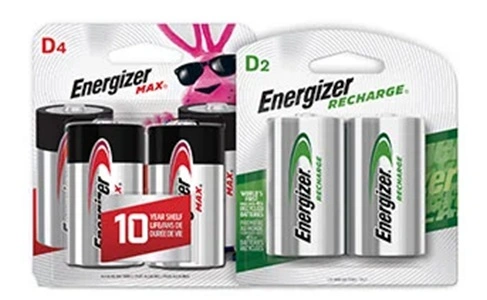When it comes to powering devices, understanding the type of batteries you need can make all the difference in ensuring optimal performance and longevity. Among the various battery sizes and configurations, D batteries are a popular choice for high-drain devices like flashlights, radios, and certain medical equipment. Within the D battery category, terms like D2 and D4 are often encountered, leading to confusion about their differences and uses.
This article explores the difference between D2 and D4 batteries, their applications, and how to choose the right type for your needs.
What Are D Batteries?

D batteries, also known as size D cells, are cylindrical batteries commonly used in devices that require long-lasting power and high energy output. These batteries are larger than AA, AAA, or C batteries, making them ideal for devices with higher energy consumption.
Key characteristics of D batteries:
- Size: Approximately 61.5 mm in length and 34.2 mm in diameter.
- Voltage: Typically 1.5 volts for alkaline and zinc-carbon variants; rechargeable types like NiMH may offer slightly lower voltages (1.2 volts).
- Capacity: Ranges between 8000 and 12000 mAh (milliampere-hour), depending on the type and brand.
What Are D2 and D4 Batteries?
The terms D2 and D4 refer to packaging configurations rather than specific differences in the battery size or type. Manufacturers and retailers often group D batteries into packs of two or four for convenience and marketing purposes.
D2 Batteries
- Description: A pack of two D batteries.
- Applications: Suitable for devices requiring only one or two batteries, such as certain flashlights or small portable radios.
D4 Batteries
- Description: A pack of four D batteries.
- Applications: Ideal for devices that require multiple batteries, such as boomboxes, high-powered lanterns, or toys.
Key Differences Between D2 and D4 Batteries
| Feature | D2 Batteries | D4 Batteries |
|---|---|---|
| Packaging | Comes in a pack of 2 batteries. | Comes in a pack of 4 batteries. |
| Quantity | Contains fewer batteries, suitable for devices with lower requirements. | Contains more batteries, ideal for devices needing more power. |
| Price | Generally less expensive due to the smaller quantity. | Higher upfront cost but often better value per battery. |
| Usage | For devices needing 1-2 batteries. | For devices needing 3-4 batteries or spares. |
| Convenience | Lightweight and compact. | Offers more batteries, reducing the need for frequent repurchases. |
Factors to Consider When Choosing Between D2 and D4 Batteries
1. Device Requirements: Check the number of D batteries your device needs. If your device requires only two, a D2 pack is sufficient. For devices needing more, opt for D4 to avoid multiple purchases.
2. Frequency of Use: For devices used occasionally, a smaller pack like D2 may suffice. High-usage devices, however, benefit from the larger D4 pack for convenience and cost-effectiveness.
3. Storage Needs: If you use D batteries across multiple devices, buying a D4 pack allows you to have spares on hand. Ensure proper storage in a cool, dry place to maintain battery life.
4. Budget: While D4 packs may seem more expensive initially, they often provide a lower cost per battery compared to D2 packs. This can be more economical for frequent users.
Types of D Batteries
Whether you choose D2 or D4 packaging, the type of battery inside remains the same. It’s essential to understand the various types of D batteries available to ensure compatibility and performance.
1. Alkaline D Batteries
- Features: Affordable, long-lasting, and widely available.
- Best For: Everyday devices like flashlights, toys, and radios.
- Lifespan: Non-rechargeable but can last for years in low-drain devices.
2. Rechargeable D Batteries
- Features: Can be recharged multiple times, reducing waste and long-term costs.
- Best For: High-drain devices that require frequent use, such as medical equipment.
- Lifespan: Lower initial capacity compared to alkaline, but cost-effective over time.
3. Lithium D Batteries
- Features: Lightweight, high energy density, and longer shelf life.
- Best For: Devices requiring long-lasting power, such as emergency equipment.
- Lifespan: Excellent for long-term storage and extreme temperatures.
4. Zinc-Carbon D Batteries
- Features: Low-cost option with a shorter lifespan.
- Best For: Low-drain devices like simple clocks or flashlights.
- Lifespan: Typically less durable than alkaline or lithium batteries.
Benefits of D2 and D4 Battery Packs
D2 Packs
- Compact and portable.
- Ideal for casual users or low-frequency device needs.
- Easier to store if you have limited space.
D4 Packs
- Cost-efficient for bulk users.
- Reduces the frequency of repurchases.
- Convenient for households or businesses with multiple D-battery devices.
Tips for Using D Batteries
- Check Device Compatibility: Always verify the voltage and battery type required by your device before purchasing.
- Store Properly: Keep batteries in a cool, dry place to maximize shelf life. Avoid extreme temperatures.
- Dispose Responsibly: Recycle batteries according to local regulations to minimize environmental impact.
- Consider Rechargeables: For high-drain devices, rechargeable D batteries can save money and reduce waste.
- Avoid Mixing Types: Use the same type and brand of batteries within a device to prevent performance issues.
Applications of D Batteries
D batteries are versatile and commonly used in:
- Flashlights and lanterns
- Portable radios
- Children’s toys
- Medical devices
- Portable speakers or boomboxes
- Emergency equipment like sirens and alarms
The choice between D2 and D4 depends on the specific power requirements of these devices.
Conclusion
The terms D2 and D4 batteries primarily refer to packaging sizes rather than any functional difference in the batteries themselves. Whether you choose a D2 or D4 pack depends on your device’s requirements, frequency of use, and budget. D2 packs are ideal for casual users or devices needing fewer batteries, while D4 packs are better suited for high-usage scenarios or those requiring spare batteries.
Understanding the differences between battery types (alkaline, rechargeable, lithium, etc.) is equally important to ensure your devices operate efficiently and reliably. By considering your specific needs, you can make an informed decision and get the most value out of your battery purchase.



